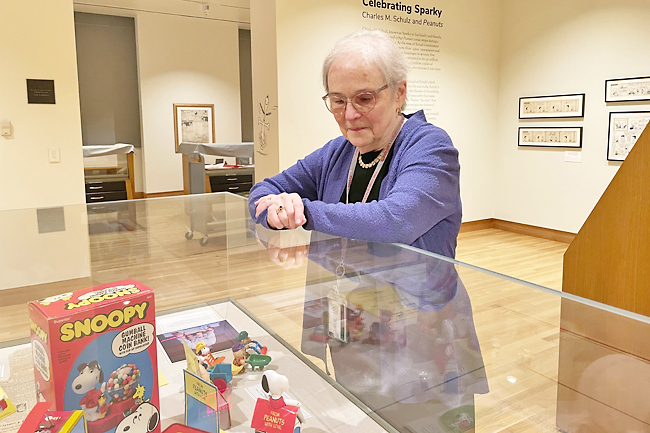COLUMBUS, Ohio (AP) – In a series of Peanuts comic strips that ran in mid-April of 1956, Charlie Brown grasps the string of his kite, which was stuck in what came to be known in the long-running strip as the “kite-eating tree”.
In one episode that week, a frustrated Charlie Brown declines an offer from nemesis Lucy for her to yell at the tree. “If I had a kite caught up in a tree, I’d yell at it,” Lucy responds in the last panel.
The simplicity of that interaction illustrates how different “Peanuts” was from comics drawn before its 1950 debut, said founding curator of the Billy Ireland Cartoon Library and Museum at Ohio State University in Columbus Lucy Shelton Caswell the world’s largest such museum.
“The idea that you could take a week to talk about this, and it didn’t have to be a gag in the sense of somebody hitting somebody else over the head with a bottle or whatever,” Caswell said. “This was really revolutionary.”
New exhibits on display at the Billy Ireland museum and at the Charles M Schulz Museum and Research Center in Santa Rosa, California, are celebrating the upcoming centenary of the birth of Peanuts cartoonist Schulz, born in Minnesota on November 26, 1922.

Schulz carried the lifelong nickname of Sparky, conferred by a relative after a horse called Sparky in an early comic strip, Barney Google.
Schulz was never a fan of the name Peanuts, chosen by the syndicate because his original title, ‘Li’l Folks’, was too similar to another strip’s name.
But the Columbus exhibit makes clear through strips, memorabilia and commentary that Schulz’s creation was a juggernaut in its day.
At the time of Schulz’s retirement in 1999 following a cancer diagnosis, his creation ran in more than 2,600 newspapers, was translated into 21 languages in 75 countries and had an estimated daily readership of 355 million. Schulz personally created and drew 17,897 Peanuts strips, even after a tremor affected his hand.
The strip was also the subject of the frequently performed play, You’re a Good Man, Charlie Brown as well as Snoopy: The Musical, dozens of TV specials and shows, and many book collections.
Creator of Calvin and Hobbes described Bill Watterson, in a 2007 Wall Street Journal review of a Schultz biography the difficulty of looking at Peanuts with fresh eyes because of how revolutionary it was at the time.
Curator of the Schulz museum Benjamin Clark describes that innovation as Schulz’s use of a spare line that maintains its expressiveness.
Schulz “understood technically in drawing that he could strip away what was unnecessary and still pack an emotional punch with the simplest-appearing lines,” Clark said. “But that simplicity is deceptive. There’s so much in these.”
The exhibit in Columbus displays strips featuring 12 “devices” that Schulz thought set Peanuts apart, including episodes involving the kite-eating tree, Snoopy’s doghouse, Lucy in her psychiatry booth, Linus’ obsession with the Great Pumpkin, the Beethoven-playing Schroeder, and more.
“Celebrating Sparky” also focusses on Schulz’s promotion of women’s rights through strips about Title IX, the groundbreaking law requiring parity in women’s sports; and his introduction of a character of colour, Franklin, spurred by a reader’s urging following the assassination of Martin Luther King Jr.
In addition, the display includes memorabilia, from branded paper towels to Pez dispensers, part of the massive Peanuts licensing world.




